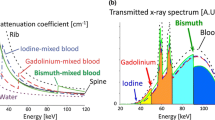Abstract
Photon-counting detector-based computed tomography (PCD CT) offers the unique ability to capture X-ray attenuation information at multiple user-defined energy ranges. This is achieved using novel semiconductor technology where X-rays are directly converted to electronic measurements without having to first convert to visible light, as performed conventionally in current clinical CT detectors. This allows a reduction in detector pixel sizes to enable high-resolution CT imaging without any dose penalty. Acquiring energy-resolved X-ray information using PCDs provides several benefits such as electronic noise reduction, artifact reduction, improved image contrast through uniform X-ray weighting, and K-edge imaging to discriminate contrast pharmaceuticals and targeted biomarkers. In this chapter, we introduce the basic principles of PCD CT, preclinical applications pertaining to neurological imaging, and a case report demonstrating dose efficient high-resolution CT imaging using a whole-body research PCD-CT system.
Access this chapter
Tax calculation will be finalised at checkout
Purchases are for personal use only
Similar content being viewed by others
References
Baert AL, et al., editors. Dual energy CT in clinical practice. Medical radiology—diagnostic imaging. Heidelberg: Springer; 2011.
Schlomka JP, et al. Experimental feasibility of multi-energy photon-counting K-edge imaging in pre-clinical computed tomography. Phys Med Biol. 2008;53(15):4031–47.
Hubbell JH, Seltzer SM. NIST X-ray mass attenuation coefficients—NISTIR 5632; 1996.
Yu Z, et al. Noise performance of low-dose CT: comparison between an energy integrating detector and a photon counting detector using a whole-body research photon counting CT scanner. J Med Imaging. 2016;3(4):043503.
Rajendran K, et al. Reducing beam hardening effects and metal artefacts in spectral CT using Medipix3RX. J Instrum. 2014;9(03):P03015.
Zhou W, et al. Metal artifact reduction and dose efficiency improvement on photon counting Ct using an additional tin filter. Med Phys. 2017;44(6):3235.
Kakinuma R, et al. Ultra-high-resolution computed tomography of the lung: image quality of a prototype scanner. PLoS One. 2015;10(9):e0137165.
McCollough CH, et al. Spatial resolution improvement and dose reduction potential for inner ear CT imaging using a z-axis deconvolution technique. Med Phys. 2013;40(6):061904.
Koenig T, et al. How spectroscopic x-ray imaging benefits from inter-pixel communication. Phys Med Biol. 2014;59(20):6195–213.
Taguchi K, Iwanczyk JS. Vision 20/20: single photon counting x-ray detectors in medical imaging. Med Phys. 2013;40(10):100901.
Leng S, et al. Spectral performance of a whole-body research photon counting detector CT: quantitative accuracy in derived image sets. Phys Med Biol. 2017;62(17):7216–32.
Faby S, et al. Performance of today’s dual energy CT and future multi energy CT in virtual non-contrast imaging and in iodine quantification: a simulation study. Med Phys. 2015;42(7):4349–66.
Anderson NG, Butler AP. Clinical applications of spectral molecular imaging: potential and challenges. Contrast Media Mol Imaging. 2014;9(1):3–12.
Schirra CO, et al. Spectral CT: a technology primer for contrast agent development. Contrast Media Mol Imaging. 2014;9(1):62–70.
Rink K, et al. Investigating the feasibility of photon-counting K-edge imaging at high x-ray fluxes using nonlinearity corrections. Med Phys. 2013;40(10):101908.
Touch M, et al. A neural network-based method for spectral distortion correction in photon counting x-ray CT. Phys Med Biol. 2016;61(16):6132–53.
Yu Z, et al. How low can we go in radiation dose for the data-completion scan on a research whole-body photon-counting computed tomography system. J Comput Assist Tomogr. 2016;40(4):663–70.
Yu Z, et al. Initial results from a prototype whole-body photon-counting computed tomography system. Proc SPIE Int Soc Opt Eng. 2015;9412:94120W.
Leng S, et al. Dose-efficient ultrahigh-resolution scan mode using a photon counting detector computed tomography system. J Med Imaging (Bellingham). 2016;3(4):043504.
Krauss B, Schmidt B, Flohr TG. Dual energy CT in clinical practice. In: Baert AL, et al., editors. Medical radiology—diagnostic imaging. Heidelberg: Springer; 2011. p. 11–20.
Gutjahr R, et al. Human imaging with photon counting–based computed tomography at clinical dose levels: contrast-to-noise ratio and cadaver studies. Invest Radiol. 2016;51(7):421–9.
Symons R, et al. Photon-counting computed tomography for vascular imaging of the head and neck: first in vivo human results. Invest Radiol. 2018;53(3):135–42.
Zhou W, et al. Reduction of metal artifacts and improvement in dose efficiency using photon-counting detector computed tomography and tin filtration. Invest Radiol. 2019;54(4):204–11. https://doi.org/10.1097/RLI.0000000000000535.
Stierstorfer K, et al. Weighted FBP—a simple approximate 3D FBP algorithm for multislice spiral CT with good dose usage for arbitrary pitch. Phys Med Biol. 2004;49(11):2209–18.
Author information
Authors and Affiliations
Corresponding author
Editor information
Editors and Affiliations
Rights and permissions
Copyright information
© 2020 Springer Nature Switzerland AG
About this chapter
Cite this chapter
Rajendran, K., McCollough, C.H. (2020). Photon-Counting Detector-Based Computed Tomography. In: Mannil, M., Winklhofer, SX. (eds) Neuroimaging Techniques in Clinical Practice. Springer, Cham. https://doi.org/10.1007/978-3-030-48419-4_8
Download citation
DOI: https://doi.org/10.1007/978-3-030-48419-4_8
Published:
Publisher Name: Springer, Cham
Print ISBN: 978-3-030-48418-7
Online ISBN: 978-3-030-48419-4
eBook Packages: MedicineMedicine (R0)




